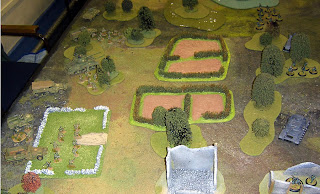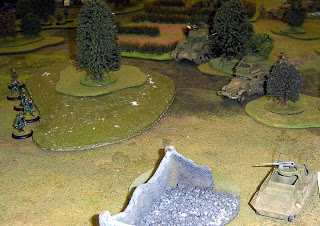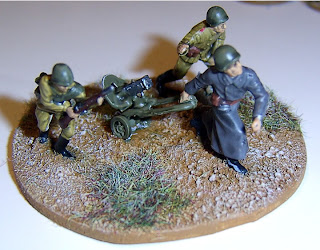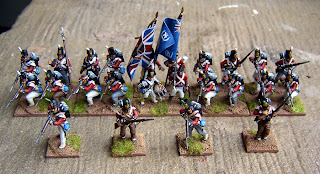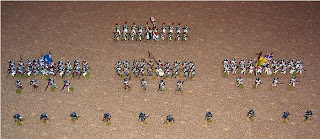
Well, there is a swing in my club towards these as a set of playable rules for Napoleonics, and so I picked up a copy.
Despite a hefty page count of 223 pages I managed to read through them over the week and with the caveat that I haven't actually played them as yet, I can offer a few thoughts.
Presentation: High production values still can't hide a fistful of minor typos. Ordinarily in a book these wouldn't be more than mildly diverting; but in wargame rules a point that is stated once as one set of values, and later repeated with different values is the chink in the armour that beardy players use to dig in and exploit a game. Similarly an obvious error in writing that clearly contradicts the intention of the rules will allow the 'Rules as Written' crowd to exploit an advantage. There is little of this in the book, but it shouldn't have been there at all. I spotted it on one reading in a week; did they not have time in their production schedule to put in a week for proof reading then?
Another point is that any close inspection of the photographs will show that there were actually little more than a handful of display setups of games made for photography. All the images of sample units in the army lists are photoshopped, and virtually none of the bases shown appear to exist in reality. In the group shots, 90% of the figures are based to different conventions than those recommended in the rules. So that is clearly an area of complete irrelevance to play!
Rules: You might think I'd start here, but I'd be surprised if unlike me you didn't spend your first hour just pouring through the book; taking in the above.
The rules themselves are short, simple and elegant, relying on a command card system, once forces close to a range where they could charge each other, to control the battle. It has to be said that one initial concern is that it seems likely that units will often fail command rolls, which are they key governor of action, and so stand around doing nothing an awful lot; regional commanders influence is limited, and unless you are French or blessed with good commanders your chances of operating will hover around the 50/50 mark when in range of the enemy. Not having seen this in action I may be unduly concerned, but the math suggests a possible excess of randomness here.
Another displeasing randomness is the rolling for Generals abilities at the start of the game. This means you could find your command system blessed with geniuses or hamstrung by halfwits. There is no point system to allow for buying generals of a given talent; which I would have preferred so you are stuck with this as it stands. Knowing my luck the dice will favour me with the occupants of St. Dunstan's school for the In-bred Nobility whenever my British take the field.
That aside the forces move freely outside of contact, but once in the 'engagement range' it is down to the cards; offering a variety of expected aggressive and defensive options.
The Firing and combat is all d6's and much what you'd expect, though some of the ranges seem longer than rules like this typically go for, they are not unreasonable, (IIRC) muskets fire up to 15 inches for example. What is nice however is that there is no casualty removal. I approve of this.
If you look at casualty rates in smaller general engagements, where one regiment can be seen to act upon another, fatalities and wounds from battle are never as bloody as most wargames rules would imply. However the morale effect of attritional loses is seldom handled well. In both these aspects it looks to me like the rules get things right; units at least appear at full strength until destroyed; which will almost always be as a result of routing from the table, and the effect of casualties on the morale of the unit is to my mind believable - there will always come a point where no matter how good the unit, it's position on the battlefield will become untenable.
Rules for terrain, weather, skirmishers, engineers and so on are included, but none of this causes the rules to stretch much beyond 80 generally well laid out and clearly explained pages.
Scale: Obviously intended for 28mm, the only games in action I've seen have been played in 15mm by halving all the stated sizes. Units are notionally formed of six bases of 4 figures for foot troops, on 40x40mm bases. Now this matches almost no-ones established collections, though it is becoming more of a standard with newer collectors.
I must point out that the stated unit sizes are, due to the game mechanics, almost totally irrelevant. You have the same game with units of four bases of 6 figures as with 6 of 4. You have the same game if one side is on 60x20mm and the other on 45x40mm. So long as the number of figures in the unit is roughly the 24 suggested, and the footprint of similar units in armies are about the same, the game will play as intended.
You can virtually ignore their recommendations, as I said in most of their own photo's it's obvious they would.
Incidentally the game is written with 4 feet wide tables in mind, This allows little space for manoeuvre, but a 5 or 6 foot wide table with both sides starting further apart would easily remedy this.
Army Lists: The next major section; and a bit of a mixed feast. Some armies are covered in great depth, notably:
- France: including most fronts from 1805-14
- Britain: for the Peninsular campaigns
- Austria: for the period 1805-14
- Prussia: for the same period
- Russia: for the same period, with additional rules for the 1812 campaign
Others, and I think anyone who even vaguely knows the period can spot at least one, are not covered at all. Many minor armies, and some major ones are not covered at all either; so no list for the Spanish, Italians, Swedes, Minor German states (except Bavaria, covered under a French list), Poles, Turks, Egyptians, etc...
This is where the fact that the rules are specifically supporting Foundry's own range of models becomes abundantly clear. If they don't make models for it they haven't included it in the rules. That is highly annoying, but in this day and age unsurprising. Hopefully they'll have the decency to release a supplemental set at some point; otherwise enthusiasts will soon clutter the net with amendments and additions.
Background and supporting detail: Mainly as part of the army lists there is a fair deal of supporting material; the rules will serve as a good uniform guide for the basics of the covered forces; and history of the campaigns are given in brief. Still it can only be little more than an introduction. There are two painting guides, one is the super detail option few of us can expect to achieve for more than a couple of models a month, and is just as much a huge plug for the Foundry paint range, the other is full of good practical advice for getting units churned out effectively, if not so prettily. I think the latter is the more useful.
So overall. There is a lot to like, but it could have benefited from a little more time and a little less of an 'in-house production feel'. With Black Powder on the horizon and no shortage of established rules out there with their own adherents, you have to wonder if Napoleon will be a long term success. But in the rules themselves, I think, and I cannot confirm it yet, that Matthew Fletcher has come up with the goods, neither off-puttingly complex, nor childishly simple.
 The 16th was part of Wellington's Peninsula Army 1809 - 14, winning major battle honours at Talavera, Salamanca and Vittoria. In 1815 they fought in the final defeat of Napoleon at Waterloo, in Belgium.
The 16th was part of Wellington's Peninsula Army 1809 - 14, winning major battle honours at Talavera, Salamanca and Vittoria. In 1815 they fought in the final defeat of Napoleon at Waterloo, in Belgium. The ensign is highly speculative, but only included because the Front Rank battalion pack includes one. Overall I love the quality of the Fronk Rank miniatures, but the lack of variety in the posing is less pleasing. Still at under £2.40 a piece for metal cavalry, they aren't bad. The chest lace should perhaps only be silver for officers, but the effect is nice so I doubt I'll change it.
The ensign is highly speculative, but only included because the Front Rank battalion pack includes one. Overall I love the quality of the Fronk Rank miniatures, but the lack of variety in the posing is less pleasing. Still at under £2.40 a piece for metal cavalry, they aren't bad. The chest lace should perhaps only be silver for officers, but the effect is nice so I doubt I'll change it. Lovely vivid green uniforms. These are all portrayed as voltiguers, including an officer and a bugler. Made from a variety of spare victrix figures, including at least three officer and a drummer torso!
Lovely vivid green uniforms. These are all portrayed as voltiguers, including an officer and a bugler. Made from a variety of spare victrix figures, including at least three officer and a drummer torso!

